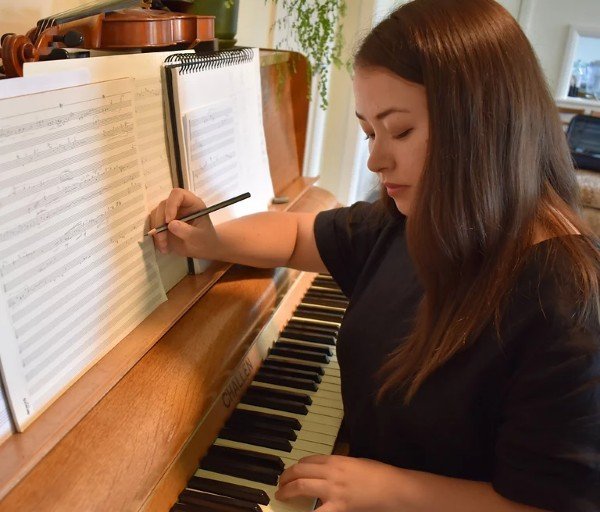Shifting 1 - Performance Notes
Welcome to Shifting!
After another year of canceled shows and disappointment, we’re thrilled to be back on stage to perform for you this rich and diverse program that reaches across countries and times. As a new art organisation we are committed to presenting new, lesser-known, and emerging voices.
If you enjoy this evening’s performance, think about attending Shifting 2 (25 February 7pm & 26 February 7pm) where we perform large ensemble works from across the Asia-Pacific.
We have also just announced two other performances: Diapsalmata featuring the music of Kym Dillon and Folding a new dance-baroque music collaboration curated by Kim Tan and featuring dance and choreography from Ashley Dougan.
Finally, we have also launched our digital reimagining of Arnold Schoenberg’s epoch-defining Pierrot Lunaire. Explore the moonlit world from the comfort of your own home, encompassing dance, video, design, visual art, prose, poetry, and chamber music.
As with all Forest Collective shows we welcome you to clap when you feel.
You’re welcome to document your experience on your phone, however, please respect your fellow concert-goers. And be sure to tag us! #forestcollective @forestcollective
- Evan J Lawson, artistic director.
Forest Collective acknowledges the Traditional Custodians of the land on which we live, meet, create, and perform - primarily Wurundjeri land of the Kulin Nation.
We pay our respects to their Elders, past and present, and extend our respects to all Australian Aboriginal and Torres Strait Islander Elders, past and present. We recognise and respect their cultural heritage, beliefs, and relationship with the land. We recognise Australian Aboriginal and Torres Strait Islander peoples as the first inhabitants of this nation.
The foundations of Western philosophy can be seen in ‘Cogito, ergo sum’ (‘I think, therefore I am’), a philosophical statement used by René Descartes in his Discourse on Method (1637). Although the idea expressed in ‘Cogito, ergo sum’ is widely attributed to Descartes, many predecessors offer similar arguments — particularly St. Augustine of Hippo in De Civitate Dei: ‘Si […] fallor, sum’ (‘If I am mistaken, I am’) (book XI, 26).
“For if I am mistaken, I am. For one who does not exist cannot be mistaken either.” – St. Augustine of Hippo
Si fallor, sum is written as a concert-opening piece with its brash opening chords that wakes the audiences’ ears. These chords cast the foundations of the harmonic language and melodic motives to follow in the piece. Si fallor, sum is like a smorgasbord of sounds, created by the organic, spontaneous and continuous development of the opening gesture; like Si fallor, sum had developed into what we see as Western philosophical thought today.
-Emily Koh
Premiere: March 19 2009 | Hui-Ling Khoo | Conservatory Concert Hall / Singapore
LUO Zhongrong (罗忠榕) (b. 1924 )
Crossing the river to pick hibiscus (1979)
For voice and piano
dur. 2”
Hailed as the spiritual father of musical modernism in China, LUO translated many 20th century treatises on harmony and serialism into Chinese for the first time. He survived imprisonment and persecution during the Cultural Revolution, composing in secret, before publishing his works after ‘Reform and Opening Up’ in 1979. Crossing the river to pick hibiscus is the first work by a Chinese composer to use 12-tone serialism. LUO adapts Schönberg’s revolutionary technique into a pentatonic idiom in this setting of an anonymously composed classical poem from the Han Dynasty (202BCE - 220CE).
Crossing the river to pick hibiscus,
The orchid pond is surrounded by fragrant herbs.
I pluck a flower, but for whom?
The one I think of is far away.
I look back towards the old village,
The long road stretches out before me –
Far from my soul mate and my home.
I am distressed by my old age.
(trans. Daniel Szesiong Todd)
Elliott Gyger (1968)
Shifting (2007)
For cello
dur. 8”
shifting: hand position on the fingerboard
bow position on the string
gears
colours
shapes
moods
weight
planes
perspectives
perceptions
-Elliott Gyger
Salina Fisher (1993)
Komorebi (2014)
For violin and vibraphone
dur. 8”
This is my response to the beautiful Japanese word ‘Komorebi’ which means ‘sunlight that filters through the leaves of trees’. The piece is based on the Ryukyu mode of Okinawa, Japan.
-Salina Fisher
Komorebi won the 2014 New Zealand School of Music Composers Competition
Ravi Shankar (1920 - 2012)
Sonata (1998)
For harp and cello
Shankar’s Sonata for Harp and Cello was written in 1998 for his good friend Mstislav Rostropovich. The work is imbued with elements of the North Indian rāga tradition, which focusses primarily on rhythm and melody, rather than harmonic development. In this tradition, performers become immersed in a semi-meditative state, as the rāga speaks through them and leads musicians and listeners towards moksha - a spiritual liberation from the confines of humanity. Shankar’s Sonata was premiered in 1999 by Rostropovich and Czech harpist Jana Boušková.
Interval
LUO Zhongrong (罗忠榕) (b. 1924 )
Three Autumn Songs 秋之歌 (1962)
1. Mountain Journey 山行
2. On Nanling Road 南陵道中
3. To Hanchuo, Magistrate of Yangzhou 寄揚州韓綽判官
For voice and piano
dur. 4”
LUO composed this set of three autumn songs using famous quatrains by Tang Dynasty poet DU Mu (803-852). Written in 1962 - four years before the outbreak of the Cultural Revolution - these songs are completely tonal, yet still demonstrate LUO’s stylistic development of the Chinese art song. In the third song in particular, the piano part imitates traditional Chinese instruments including the Dizi (bamboo flute) and Guzheng (hammer dulcimer).
1. Mountain Journey
Far away on a cold mountain, a rocky path wends,
Deep within the white clouds, there seem to be houses.
I stop to enjoy the maple forest at nightfall,
Frosty leaves are redder than February flowers.
2. On Nanling Road
The water’s surface at Nanling flows long and leisurely,
an urgent wind and gentle clouds anticipate autumn’s arrival.
Just as the lonely traveller yearns for the wind to carry him home,
where someone’s red sleeve is leaning against his house.
3. To Hanchuo, Magistrate of Yangzhou
The mountains are blue and hazy, the waters are far away,
autumn has reached Jiangnan, but the grass has not yet withered, ah!
Twenty-four bridges in the bright moonlit night,
where beautiful people teach you how to play the flute, ah!
(DU Mu, trans. Daniel Szesiong Todd)
Carrying
Australian premiere
For flute and contrabass recorder
dur. 12”
"Of his 'Carrying', for flute and bass recorder, Dylan writes that the music, "moves in a stream of ambiguity of interiors, where both voices share and bear musical duty equally, and waver between realisations of the unity of the meta-instrument, and the dispersed voices of opaque multiple-part choirs." - SOUNZ
Margaret Sutherland (1887 - 1984)
Sonata (1942)
For cello and piano
dur. 12”
Read more about this work here.






